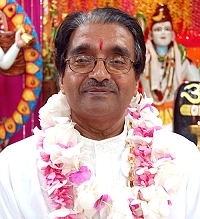From an interview with Paramacharya of SWAHA, Pt. Hardeo Persad
The Shiva lingam is symbolic of the source of infinite power. He is the substratum, the essence of all creation; Paramshiva, the basis of all things. His form represents the state of dispassion and each symbol associated with it is deeply meaningful. For example, He is depicted as being white in colour with a blue throat, where He stores the poison of materialistic consumption to save the world. The colour white, sent through a prism, emerges as all the colours of the spectrum: red, orange, yellow, blue, green, indigo and violet. It is, therefore, the basis of all colours, just as everything emanates from the substratum, Shivaji. Furthermore, it means, as the scriptures declare: Chidananda Rupaha, Shivoham, Shivoham: “I am the form of Consciousness and Bliss; I am Shiva.” We can reach the highest state of realisation by reflecting on these symbols.
Shiva carries with him a damaru (drum), which creates all the rhythms that pulsate in this world. In fact, everything in this world is rhythmic and cyclical; the bhajan states: Dimika dimika dim, damaru baaje. As Nataraj, He performs the dance of creation and dissolution of this world. Out of His damaru, there emanates, like a seed, the Maheshwara sutra, the law of creation. It is the first vibration ever created, which in Hinduism, is the word, Om. He is thus the source of all things.
His matted locks are also deeply significant. In the human body there are five major vital airs: praana, apaana, samaana, udaana and vyaana vaayu and five minor ones: naga, kurma, krkara, devata and dhananjaya vayu. Together they control all the body’s metabolic activity. Shiva sits in meditation for thousands of years without any activity and tying the matted locks signifies harnessing all the vital airs. They are placed in a state of inertia so that nothing occurs inside the body. He has absolute control over the human body as the Maha Yogi.
The river Ganga that flows from his hair is the stream of devotion in all of us. Shiva represents pure dispassion. Thus, with dominance over all the activities of the body and dispassion, one can develop the highest state of pure devotion (bhakti). The trishul or trident represents the triguna: Brahma, Vishnu and Shiva (Creator, Sustainer, Dissolver). It also signifies the three states of time: past, present and future, as well as the three planes of existence: bhu, bhuvah, swah (physical, astral, causal). Shiva knows past, present and future and is beyond time. He bestows blessings on the three planes of existence. The serpent coiled around His neck represents the individual ego, which should adorn the Cosmic Ego, Shivaji. It also represents the cycle of time in years. He is the Master of time, Maha Kaal.
The auspicious celebration of Maha Shiv Raatri reminds each individual of the journey one must embark upon in order to realise Shivaji and to purify the intent with which it is done. The ritualistic actions of jal-offering, havan, abhishek, fasting, mantra–jap and pujaa, combined with the practice of rising above the limitations of this world, takes one nearer to the ultimate goal of Divinity.



